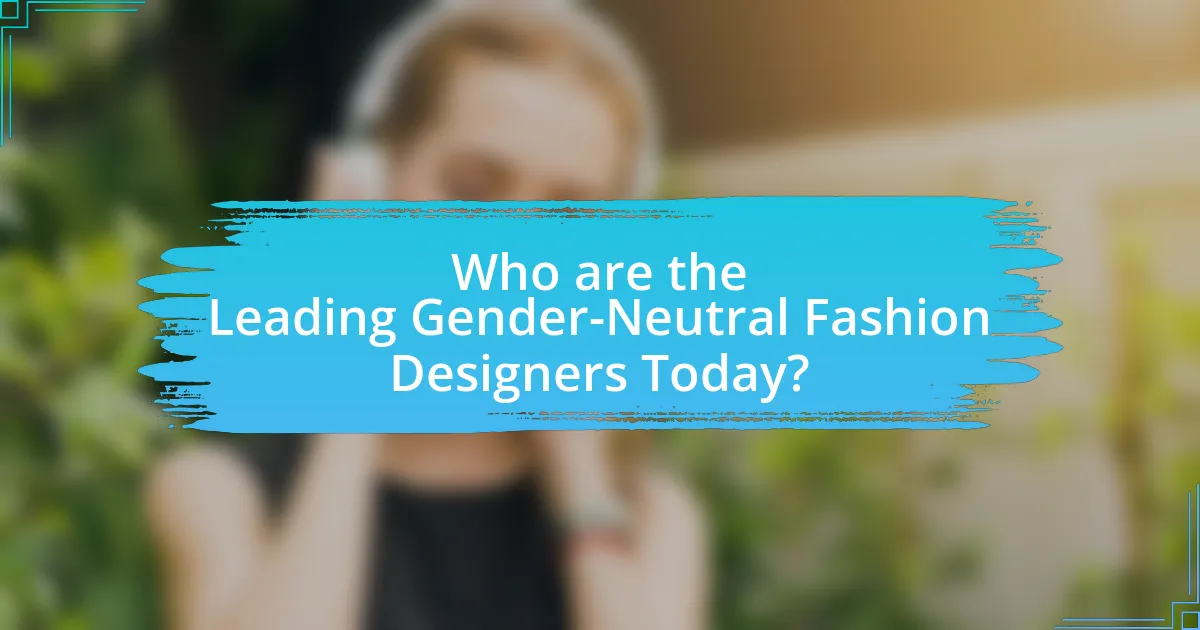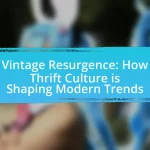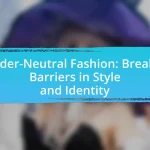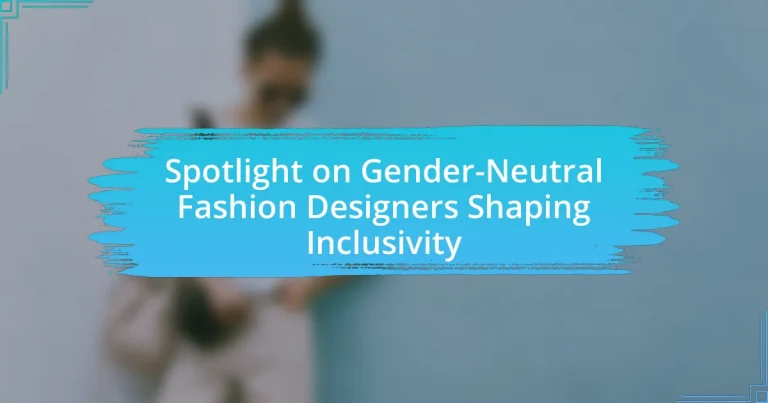Gender-neutral fashion is a clothing approach designed for individuals regardless of their gender identity, promoting inclusivity and challenging traditional gender norms. This article explores the significance of gender-neutral fashion, highlighting its differences from traditional fashion, key characteristics, and the growing popularity driven by societal shifts towards acceptance of diverse gender identities. It examines the role of leading designers like Telfar and Rad Hourani in promoting inclusivity, the impact of their work on consumer perceptions, and the challenges they face within the mainstream fashion industry. Additionally, the article discusses strategies for supporting gender-neutral fashion initiatives and resources available for those interested in this evolving sector.

What is Gender-Neutral Fashion and Why is it Important?
Gender-neutral fashion refers to clothing designed to be worn by individuals regardless of their gender identity, promoting inclusivity and breaking traditional gender norms. This approach is important because it challenges societal expectations surrounding gendered clothing, allowing for greater self-expression and comfort for all individuals. The rise of gender-neutral fashion reflects a broader cultural shift towards acceptance and recognition of diverse gender identities, as evidenced by the increasing number of brands and designers, such as Telfar and Rad Hourani, who prioritize unisex designs in their collections.
How does Gender-Neutral Fashion differ from Traditional Fashion?
Gender-neutral fashion differs from traditional fashion primarily in its rejection of gender-specific clothing categories. Traditional fashion typically adheres to binary gender norms, offering distinct styles and fits for men and women, while gender-neutral fashion promotes inclusivity by designing garments that can be worn by anyone, regardless of gender identity. This approach is supported by the growing movement towards inclusivity in the fashion industry, which has seen brands like Telfar and Rad Hourani gaining recognition for their unisex collections. These designers emphasize versatility and comfort, often utilizing neutral colors and relaxed silhouettes that challenge conventional gendered aesthetics.
What are the key characteristics of Gender-Neutral Fashion?
Gender-neutral fashion is characterized by its inclusivity, versatility, and lack of gender-specific design elements. This fashion approach eliminates traditional gender norms by offering clothing that can be worn by anyone, regardless of their gender identity. Key features include unisex silhouettes, neutral color palettes, and adaptable styles that prioritize comfort and functionality over conventional gender distinctions. The rise of gender-neutral fashion reflects a broader societal shift towards acceptance and representation, as seen in the increasing number of brands and designers embracing this concept, such as Telfar and Rad Hourani, which have gained recognition for their commitment to inclusivity.
Why is Gender-Neutral Fashion gaining popularity?
Gender-neutral fashion is gaining popularity due to a growing societal shift towards inclusivity and the rejection of traditional gender norms. This trend is supported by increasing awareness of gender identity and expression, as well as a demand for clothing that allows individuals to express themselves without the constraints of binary gender categories. According to a 2021 report by McKinsey & Company, 67% of consumers aged 18-24 prefer brands that promote inclusivity, indicating a significant market shift. Additionally, major fashion brands are increasingly adopting gender-neutral lines, reflecting this cultural change and catering to a diverse consumer base.
What role do Gender-Neutral Fashion Designers play in promoting Inclusivity?
Gender-neutral fashion designers play a crucial role in promoting inclusivity by creating clothing that transcends traditional gender norms. These designers challenge the binary classification of male and female apparel, allowing individuals of all gender identities to express themselves freely. For instance, brands like Telfar and Rad Hourani have gained recognition for their unisex collections, which cater to diverse body types and gender expressions. This approach not only broadens the market but also fosters a sense of belonging among consumers who may feel marginalized by conventional fashion standards. By prioritizing inclusivity, gender-neutral designers contribute to a cultural shift that values diversity and self-expression in the fashion industry.
How do these designers challenge traditional gender norms?
Designers challenge traditional gender norms by creating gender-neutral clothing that defies binary classifications of male and female attire. For instance, brands like Telfar and Eckhaus Latta produce collections that prioritize inclusivity, allowing individuals to express their identity without conforming to societal expectations. This approach is supported by the growing demand for unisex fashion, which reflects a cultural shift towards acceptance of diverse gender identities and expressions.
What impact do they have on consumer perceptions of gender in fashion?
Gender-neutral fashion designers significantly influence consumer perceptions of gender in fashion by challenging traditional gender norms and promoting inclusivity. Their designs often blur the lines between masculine and feminine aesthetics, encouraging consumers to embrace a more fluid understanding of gender identity. For instance, brands like Telfar and Eckhaus Latta have gained popularity for their unisex collections, which reflect a growing societal shift towards acceptance of diverse gender expressions. This shift is supported by research indicating that 62% of consumers prefer brands that promote gender inclusivity, highlighting the impact of these designers on consumer attitudes and behaviors in the fashion industry.

Who are the Leading Gender-Neutral Fashion Designers Today?
The leading gender-neutral fashion designers today include Telfar Clemens, known for his unisex designs and the popular Telfar Shopping Bag, and Rad Hourani, who has been a pioneer in genderless fashion since 2007. Additionally, brands like Eckhaus Latta and 69 have gained recognition for their inclusive collections that challenge traditional gender norms. These designers and brands have significantly influenced the fashion industry by promoting inclusivity and breaking down barriers between men’s and women’s clothing.
What are the notable contributions of these designers?
Notable contributions of gender-neutral fashion designers include the promotion of inclusivity and the challenge of traditional gender norms in fashion. Designers such as Rad Hourani have pioneered unisex collections that emphasize versatility and self-expression, while brands like Telfar have gained recognition for their accessible luxury and commitment to diversity. Additionally, designers like Palomo Spain have redefined masculinity through bold, gender-fluid designs, showcasing that fashion can transcend binary classifications. These contributions have significantly influenced the industry by encouraging a broader acceptance of diverse identities and styles, ultimately reshaping consumer perceptions and market dynamics.
How do their designs reflect inclusivity and diversity?
Their designs reflect inclusivity and diversity by incorporating gender-neutral silhouettes, diverse model representation, and culturally inspired patterns. Gender-neutral silhouettes allow individuals of all gender identities to wear the same pieces, promoting a sense of belonging and acceptance. Additionally, these designers often feature models of various ethnicities, body types, and ages in their campaigns, which broadens the representation in fashion and challenges traditional beauty standards. For instance, brands like Telfar and Palomo Spain have gained recognition for their commitment to inclusivity, showcasing collections that celebrate a wide range of identities and experiences, thereby reinforcing the notion that fashion can be for everyone.
What unique approaches do they take in their collections?
Gender-neutral fashion designers take unique approaches in their collections by prioritizing inclusivity and versatility in sizing, silhouettes, and styles. They often create unisex garments that challenge traditional gender norms, allowing individuals to express their identity without the constraints of conventional fashion categories. For instance, designers like Telfar Clemens emphasize functionality and comfort, producing pieces that can be worn by anyone, regardless of gender. This approach not only broadens the market appeal but also fosters a sense of community among diverse consumers, as seen in the growing popularity of brands that focus on gender-neutral aesthetics.
How do these designers influence the fashion industry as a whole?
Gender-neutral fashion designers influence the fashion industry by challenging traditional gender norms and promoting inclusivity. These designers create collections that cater to a diverse range of identities, thereby expanding the market and encouraging brands to adopt more inclusive practices. For instance, designers like Telfar Clemens and Rad Hourani have gained recognition for their unisex designs, which have led major retailers to rethink their gendered marketing strategies. This shift is evidenced by the increasing number of brands launching gender-neutral lines, reflecting a broader societal acceptance of fluid gender identities.
What trends have emerged from their work?
Emerging trends from the work of gender-neutral fashion designers include the increasing popularity of unisex clothing lines, a focus on sustainable materials, and the promotion of body positivity. These designers are redefining traditional gender norms in fashion by creating collections that cater to a diverse range of identities, thereby fostering inclusivity. For instance, brands like Telfar and Palomo Spain have gained recognition for their innovative designs that challenge conventional gender binaries, reflecting a broader societal shift towards acceptance and representation in fashion. Additionally, the use of eco-friendly fabrics aligns with a growing consumer demand for sustainability, further solidifying these trends in the industry.
How are traditional brands responding to the rise of Gender-Neutral Fashion?
Traditional brands are increasingly adopting gender-neutral fashion lines to align with evolving consumer preferences. This shift is evident as major retailers like Zara and H&M have introduced unisex collections, reflecting a growing demand for inclusivity in fashion. According to a 2021 report by McKinsey & Company, 60% of consumers are interested in gender-neutral clothing, prompting brands to rethink traditional gendered marketing strategies. Additionally, collaborations with gender-neutral designers and the incorporation of non-binary models in advertising campaigns further demonstrate traditional brands’ commitment to embracing this trend.

What Challenges do Gender-Neutral Fashion Designers Face?
Gender-neutral fashion designers face significant challenges, primarily related to market acceptance and consumer perception. Many consumers still adhere to traditional gender norms, which can limit the demand for gender-neutral clothing. According to a 2021 report by McKinsey & Company, only 25% of consumers actively seek out gender-neutral options, indicating a gap in market readiness. Additionally, designers often struggle with sourcing materials and manufacturing processes that align with their inclusive vision while maintaining profitability. The lack of established sizing standards for gender-neutral clothing further complicates production and sales, as designers must navigate a landscape that is not yet fully supportive of their innovative approaches.
What barriers exist in the mainstream fashion industry?
The mainstream fashion industry faces several barriers, including a lack of inclusivity, limited representation of diverse body types, and systemic gender norms. These barriers hinder the acceptance and promotion of gender-neutral fashion, which aims to challenge traditional gender binaries. For instance, a study by the Council of Fashion Designers of America found that only 14% of designers identify as LGBTQ+, indicating a significant underrepresentation that affects the industry’s ability to embrace inclusivity. Additionally, the prevalence of size exclusivity in fashion shows and marketing campaigns perpetuates narrow beauty standards, limiting the visibility of diverse body types and styles.
How do societal perceptions impact their work?
Societal perceptions significantly influence the work of gender-neutral fashion designers by shaping consumer expectations and market demand. Designers often respond to societal attitudes towards gender and inclusivity, which can dictate the styles, materials, and marketing strategies they employ. For instance, as public awareness of gender fluidity increases, designers like Telfar Clemens and Rad Hourani have gained prominence by creating collections that challenge traditional gender norms, reflecting a shift in consumer preferences towards more inclusive fashion. This shift is supported by research from the Fashion Institute of Technology, which indicates that 70% of consumers prefer brands that promote inclusivity and diversity. Thus, societal perceptions not only affect the creative direction of these designers but also their commercial success and relevance in the fashion industry.
What financial challenges do they encounter?
Gender-neutral fashion designers encounter significant financial challenges, including limited access to funding and investment opportunities. Many of these designers struggle to secure capital due to the niche market they operate in, which can deter traditional investors who may not fully understand the potential for growth in gender-neutral fashion. Additionally, the high costs associated with sustainable materials and ethical production practices further strain their financial resources. According to a report by the Council of Fashion Designers of America, emerging designers often face barriers in scaling their businesses, with 70% citing financial constraints as a primary obstacle to growth.
How can these challenges be overcome?
To overcome challenges in gender-neutral fashion, designers can prioritize collaboration with diverse communities to ensure representation and inclusivity in their collections. Engaging with individuals from various gender identities allows designers to understand specific needs and preferences, leading to more relevant and appealing designs. For instance, brands like Telfar and Gender Free World have successfully integrated feedback from their target audiences, resulting in collections that resonate with a broader demographic. Additionally, implementing sustainable practices can address environmental concerns while promoting inclusivity, as seen in the work of designers like Reformation, who focus on eco-friendly materials. By fostering open dialogue and embracing sustainable methods, the fashion industry can effectively tackle the challenges associated with gender-neutral design.
What strategies can designers employ to promote their work?
Designers can employ social media marketing, collaborations, and participation in fashion shows to promote their work. Social media platforms like Instagram and TikTok allow designers to showcase their collections to a global audience, with statistics showing that 73% of marketers believe that their efforts through social media marketing have been “somewhat effective” or “very effective” for their business. Collaborations with influencers or other brands can expand reach and credibility, as seen in successful partnerships like that of designer Telfar Clemens with various retailers. Additionally, participating in fashion shows provides exposure to industry professionals and potential customers, with events like New York Fashion Week attracting significant media attention and audience engagement.
How can consumers support Gender-Neutral Fashion initiatives?
Consumers can support Gender-Neutral Fashion initiatives by actively choosing to purchase from brands that prioritize inclusivity in their designs. By selecting gender-neutral clothing options, consumers signal to the fashion industry that there is a demand for such products, which can lead to increased visibility and investment in gender-neutral lines. Research indicates that the global gender-neutral fashion market is projected to grow significantly, reflecting a shift in consumer preferences towards inclusivity. This trend encourages brands to innovate and expand their offerings, ultimately fostering a more diverse and accepting fashion landscape.
What are the Best Practices for Supporting Gender-Neutral Fashion Designers?
To support gender-neutral fashion designers, stakeholders should prioritize inclusivity in marketing, provide platforms for visibility, and ensure diverse representation in fashion shows. Inclusivity in marketing involves using gender-neutral language and imagery that resonates with a broad audience, which can enhance brand loyalty and reach. Providing platforms for visibility, such as dedicated sections in retail spaces or online marketplaces, allows gender-neutral designers to showcase their work effectively. Additionally, ensuring diverse representation in fashion shows not only highlights the designers’ creations but also promotes a culture of acceptance and diversity within the industry. These practices are essential for fostering an environment where gender-neutral fashion can thrive and be recognized.
How can individuals incorporate Gender-Neutral Fashion into their wardrobes?
Individuals can incorporate gender-neutral fashion into their wardrobes by selecting versatile clothing items that are not specifically designed for one gender. This includes choosing oversized shirts, unisex trousers, and neutral-toned outerwear that can be styled in various ways. Research indicates that the rise of gender-neutral fashion is driven by a growing demand for inclusivity, with brands like Telfar and Rad Hourani leading the way in offering collections that cater to all genders. By prioritizing comfort and personal expression over traditional gender norms, individuals can create a wardrobe that reflects their identity while embracing the principles of gender-neutral fashion.
What resources are available for those interested in Gender-Neutral Fashion?
Resources available for those interested in Gender-Neutral Fashion include online platforms, educational materials, and community organizations. Websites like GenderFreeWorld and The Phluid Project offer curated collections of gender-neutral clothing, while platforms such as Pinterest and Instagram provide inspiration and trends. Educational resources, including articles and guides from fashion institutes, help individuals understand the principles of gender-neutral design. Additionally, organizations like the Gender and Fashion Network promote inclusivity and provide networking opportunities for designers and consumers alike. These resources collectively support the growing movement towards inclusivity in fashion.

















